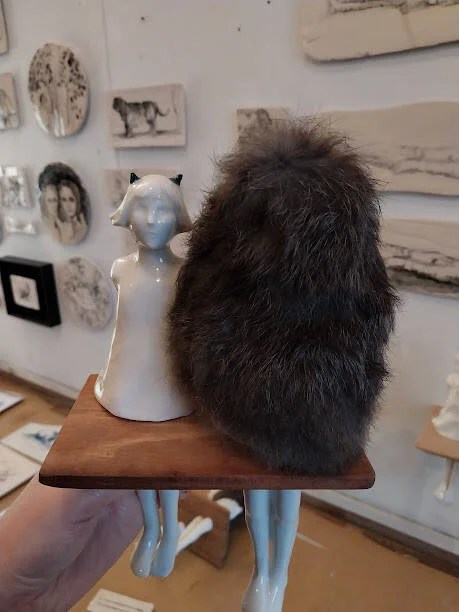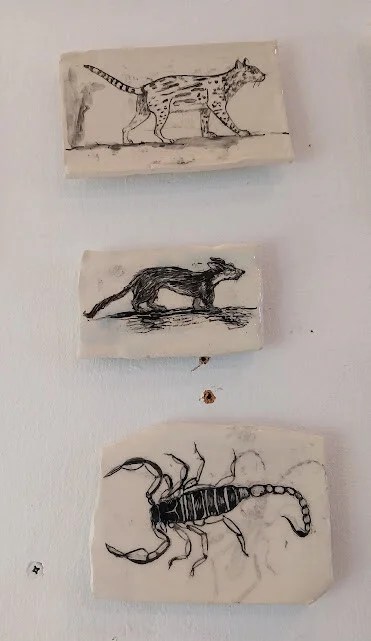DELPHINE GRENIER
The Mysterious, Emotional Resonance of Ceramics

© Delphine Grenier: portrait of the artist in her studio in Montreuil, a commune in the eastern suburbs of Paris
“The attractions of ceramics lie partly in its contradictions. It is both difficult and easy, with an element beyond our control. It is both extremely fragile and durable. Like ‘Sumi’ ink painting, it does not lend itself to erasures and indecision.”
– Isamu Noguchi
I have decided to open the year 2024 with a mesmerizing fantasy about our symbolic world of dreams, ambivalent personalities, and our connections with the ancestral, intangible world. A fantasy made primarily of ceramics and signed by Delphine Grenier. Delphine is a French artist creating in the suburbs of Paris, in her spacious atelier in Montreuil, which I had a great chance to discover thanks to her invitation. As a graduate from the School of Decorative Arts in Strasbourg, Delphine developed as an artist with a multitude of assets, from printmaking and performance to writing and ceramics. Permanently interested in portraying and questioning deeper, hidden realities and our connection with the essential, Delphine works with original, natural materials such as earth, ceramics, and paper.

© Ana Malnar: Delphine’s atelier in Montreuil, in the suburbs of Paris




© Ana Malnar: details from the Delphine Grenier’s atelier in Montreuil
How does one become a unique being,
when he is born with a duplicate of himself?
When everything is the same among twins:
Genes, eye color, facial features,
And yet, each one of them feels unique
– Delphine Grenier

© Ana Malnar: Delphine Grenier, Find the lady, two green horns with fur, porcelain and wood
Series “Twin and double” and “Find the lady”
Starting from her position as a twin sibling, the series “Find the lady” is imagined as an innocent, childlike role play. Delphine plays with a mirror effect, in which we question our proper self, our hidden desires, and our perceptions of ourselves, in comparison to the other-our double. This series of porcelain sculptures and paper drawings raises one of the deepest questions we all face: How do we exist in this world, and can we even exist independently of the “other one”, who provides us with validation and reassurance? The wooden pedestal represents a ground base for two identities. We can also imagine it as a both separating and anchoring element of the materialistic and idealistic part of one’s self. As Franz Werfel wrote in his novel “The Forty Days of Musa Dagh: “Our heart is twofold. There is a heart of flesh and another, secret and celestial, which surrounds the first, just as its perfume surrounds a rose. There is a heart of flesh and another, secret and celestial, which surrounds the first, just as its perfume surrounds a rose.”

© Ana Malnar: Delphine Grenier, “Find the lady”, simply blue horns, porcelain and wood

© Ana Malnar: Delphine Grenier, Find the lady, a pair with a fur cap and another with a fur coverage
To explore in depth the idea of the ambiguity of the self, Delphine uses symbols of ambivalent meanings. The horns, for example, are not merely a symbol of evil, as portrayed in Christian iconography. In the civilizations of ancient Near East and Mesopotamia, they were considered as a symbol of strength and fertility, because the animals that possessed them were characterized by these qualities. This brings us to the question of an exterior judge, a look outside ourselves who will decide where to place us in the spectrum of good or bad, which enhances the idea that our proper self develops primarily in relation to the other.
The fur that breaks the seemingly harmonious balance between the twins has a rich ambivalent symbolical meaning, serving both as an element of alienation from the double, and protection of one’s intimate world. Playing with fur, Delphine also makes a clear separation between the real and symbolic world, opening the space to the ancestral, world of myths, symbols, and dreams. The symbolical meaning of color, fur, and horns in her paper paintings, are also used to reveal the similarities and dichotomies of double identities, regarding the unique, the shared, the hidden, and the imagined self.

© Delphine Grenier: Twin and double, drawing with paint on paper

© Delphine Grenier: Twin and double, on the orange surface, drawing with paint on paper
Series “Little Eden” and “Ceramic whisper”
“The series Little Eden is a work in progress. It is a series of nude drawings based on my interpretation of ancient art paintings, that I associate with an extinct animal species. They both witness a specific period, interacting in a common memory, on a stage belonging to the past that gets reconstructed and revisited as a memory of a forgotten paradise”, explains Delphine.

© Delphine Grenier: from the series Little Eden, based on Titian’s Venus from Urbin, work in progress. Earthenware, oxide drawing under enamel, 8×20 cm.
The series “Little Eden” creates an atmosphere of an idyllic place, a location for sexuality and human love, similar to the description of many medieval writers. The romantic, somehow “faded” nature of this lost momentum is enhanced by the technique of oxide drawing that imparts color to glazes, engobes, bodies, and stains. On a more mystical level, “Little Eden” is the utopia of a mankind that yearns for something only known to him through abstraction- although we must not forget that, perhaps, life is a dream. As William Shakespeare would say, “We are such stuff as dreams are made on, and our little life is rounded with a sleep.” In Delphine’s garden, each animal is mirroring a human experience, as an allegory of specific human characteristics.

© Delphine Grenier: from the series Little Eden, based on Titian’s Venus from Urbin, work in progress. Earthenware, oxide drawing under enamel, 8×20 cm.
“Like the old earthenware that bears witness to the past, the Ceramics Whisper series makes up my inventory of today’s world in order to leave its trace in the world of tomorrow. Like an echo of the work of the naturalists Buffon and Daubenton, or like this phrase from Marcel Proust: ‘We only have fragmented visions of the universe'”, explains Delphine.

© Ana Malnar: Delphine Grenier, fragments from the Ceramic whisper series, oxide drawing under enamel, 0,9X1 m






© Ana Malnar: Delphine Grenier, fragments from the Ceramic whisper series, oxide drawing under enamel, 0,9X1 m, in detail
My personal reflection on this series brings me back to totemism, and even to the concept of The Spirit Animal, the one who comes to us in order to show us, through its unique character and skills, how to deal with the manifestations of our spiritual self and own purpose. Delphine’s drawings of a wild almost a cave-type woman can be viewed as a presentation of a free sexual energy, a reconnection to the feminine that was taught to be suppressed by the modern society. In this sense, animals can be viewed as a call to reconnect to our true primal nature, to liberate the repressed vital energy that transcends through time, just as ceramic does, as one of the most ancient elements in nature, dating way back to 29,000–25,000 BC.
Series “Les allongés” (“The Reclinings”)
Apart from questioning our position in relation to the other, our double, to the primal, ancestral part of our being, lastly Delphine examines the existence beyond the real, in a dematerialized, timeless world of dreams. “To dream is to cut ourselves off from the earthly field, as the ceramics of the “The Reclinings” series invite us to do, by building a sensory bridge between ourselves and the vast world”, explains Delphine. Created as independent fragments, the enameled plaques can be arranged randomly, according to our desire, reflecting the discontinuous structure of the dream.

© Delphine Grenier: The Reclinings XX, 1;7x 40 cm, oxide drawing under enamel
Delphine enhances the fragile beauty of ceramics that sometimes breaks during baking through the technique of kintsugi, the Japanese art of putting broken pottery pieces back together with gold. The kintsugi lines redefine the body separating it into individual entities, that can be felt as an autonomous part, so much as in real life, when we don’t feel with the same intensity and at the same all the parts of ourselves.

© Ana Malnar: detail of the kintsugi tehnique

© Delphine Grenier: The Reclinings, XIII, 75×19 cm, oxide drawing under enamel
With the dreamers suspended in a weightless, immaterial space, a simple question emerged without any effort: Is life just a dream? Fleeting, inconsequential, and hardly real.
Life is but a Dream
A boat, beneath a sunny sky
Lingering onward dreamily
In an evening of July
Children three that nestle near,
Eager eye and willing ear,
Pleased a simple tale to hear
Long has paled that sunny sky;
Echoes fade and memories die;
Autumn frosts have slain July.
Still she haunts me, phantomwise,
Alice moving under skies
Never seen by waking eyes.
Children yet, the tale to hear,
Eager eye and willing ear,
Lovingly shall nestle near.
In a Wonderland they lie,
Dreaming as the days go by,
Dreaming as the summers die;
Ever drifting down the stream
Lingering in the golden gleam
Life, what is it but a dream?
Lewis Carroll
More about Delphine Grenier’s artwork:
Website: http://www.delphinegrenier.com/
Instagram : @delphine.grenier
Dora Malnar
10 months ago
Wonderful article
Leave a Reply